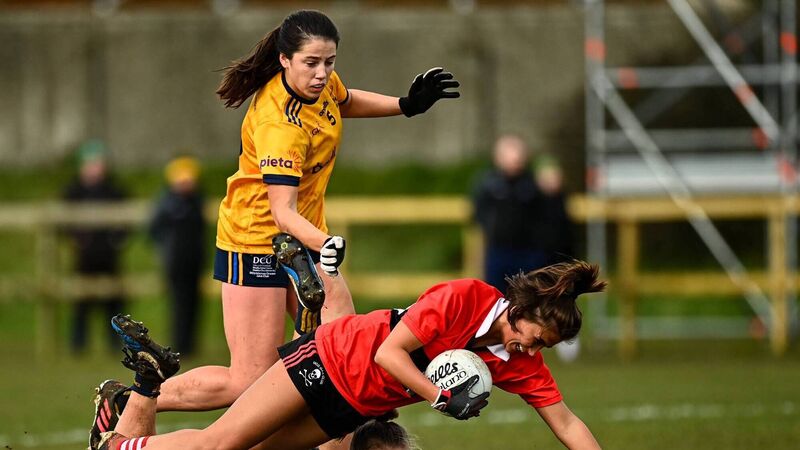Why does third-level GAA for female athletes not get the spotlight it deserves?

Ellie Jack of UCC is tackled by Jennifer Duffy of DCU Dóchas Éireann during the Yoplait LGFA O'Connor Cup semi-final last year. Picture: Eóin Noonan/Sportsfile
COLLEGE GAA is an important stepping stone for inter-county players with University College Cork winning this year's Sigerson Cup.
There has also been a huge amount of fan interest in the cups with huge attendances for group fixtures, especially in the Mardyke.
It is extremely easy to access information about the games with publicity about fixtures or results.
Between hurling and football at university level, there is a strong interest and decent coverage in the build-up. This promotion is also spurred on by the colleges themselves who of course advocate for their own teams that are involved.
Now that the college competitions for males are finished, you would assume attention would turn to the women's fixtures. This was not the case. Unless you were extremely passionate about LGFA or camogie at university level, or had someone involved, you will struggle immensely to try and even find fixtures for games.
The 2023 Yoplait Ladies Higher Education Championship began on February 8, which most people wouldn’t have even noticed due to the volume of games being played in the male version. HEC is broken down into a number of cups based on grading with some universities entering two teams.
The highest honour is the O’Connor Cup which featured UCC, UL, DCU, Queen’s University Belfast, UCD and Mary I this year. These fixtures would have passed by without anyone even noticing them being played, with the only place advertising them being the Ladies HEC Twitter page.
This is appalling compared to the male equivalent.
There may be no interest in the lower grades of cups for example the Giles Cup and Lynch Cup, but they still contain an incredible standard of football.
It shouldn’t be a matter of male and female GAA stars fighting for our attention, the problem lies in the disproportioned promotion.
A lot of people aren’t tech-savvy and trying to find results and fixtures on sites like Twitter can be a minefield, with posts dating back to the start of February.
What is most shocking about this issue is that most of the fixtures posted on the official LGFA website are outdated, with many of them only being fixed mid-way through the group stages of each cup.
How are people expected to support and promote ladies GAA when they can’t even find out when the games are taking place?
Understandably the group stages of any competition might not be of interest to fans, but even the quarterfinals of the HEC cups were not well publicised. This is incredibly annoying as women's sports in general struggle to gain any traction in media compared to male sports.
There were reports on the semi-finals and finals in mid-March but it almost felt like too litte, too late.
It’s a shame that such a big competition as the O’Connor Cup is not getting the recognition it deserves compared to the media attention given to both the Sigerson and Fitzgibbon events.
There is a positive change in the volume of content being published in the runup to the semi-finals in each cup but again this promotion is limited and can only be found on the HEC social media and the LGFA website.
Why is there not more traditional forms of promotion being optimised by the LGFA which has been done successfully by the male version of this campaign?
Do people just not care about ladies’ football at a university level?
It's hard to imagine that people take no notice of the competitions as many of the teams include young inter-county players who line out for their counties week in and week out.
It can nearly be guaranteed that there won’t be as much hype or fan attendance at the lady’s finals compared to the numbers watching the men.
The LGFA should be doing everything in its power to promote ladies GAA at every level but especially college as there seems to be a lack of care.









 App?
App?







